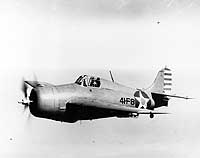
The Grumman F4F was the primary Navy and Marine Corps fighter during the first year and a half of World War II. A developed form, the General Motors FM-2, remained in active combat through the end of the Pacific War. Though the stubby little F4F could not equal the speed and maneuverability of its Japanese counterpart, the "Zero", its rugged construction and superior armament, coupled with well-trained pilots and good tactics, ensured that it generally gave at least "as good as it got" during the crisis months of 1942.
The F4F-1 was a biplane design, whose clear inferiority to the monoplane Brewster F2A-1 caused its complete recasting into the single-wing XF4F-2. When the Brewster fighter was chosen for production, Grumman's prototype was rebuilt as the XF4F-3 with new wings and tail and a supercharged version of the Pratt & Whitney R-1830 "Twin Wasp" radial engine. Testing of the XF4F-3 led to an order for F4F-3 production models, the first of which was completed in February 1940. France also ordered the type, powered by Wright R-1820 "Cyclone" radial engines. These ultimately went to the British Royal Navy, which called them "Martlet I"s. Both the British planes and the U.S. Navy's F4F-3 joined active units in 1940 with an armament of four .50 caliber Browning machine guns and a good ammunition supply.
By the end of 1941 the Grumman F4F-3 (and similar F4F-3A) fighters, which had received the popular name "Wildcat" a few months earlier, had replaced the F2A in most U.S. Navy and Marine Corps fighting squadrons. A folding-wing version flew in April 1941 and entered service in early 1942 as the F4F-4. Prompted by British tactical concepts, it had six guns but less ammunition. The heavier F4F-4 was not as nimble nor as fast as the F4F-3, but the logic of wartime manufacturing left it as the sole remaining production version, and its folding wings made it possible to cram more valuable fighters into each aircraft carrier. By the Battle of Midway in June 1942, all the Pacific Fleet's carriers had the F4F-4 and fighting squadron pilots were learning, sometimes painfully, how to best employ it. Employ it they did, quite successfully, through the Pacific's intense Guadalcanal and Central Solomons campaigns and the Atlantic's North African operation.
In late 1942 and early 1943, Grumman phased out production of the F4F-4 and General Motors' Eastern Aircraft Division took it up as the FM-1 (with two less guns). In all, the two companies produced some three-thousand "Wildcats" for the U.S. and Britain before GM's factories switched to the updated FM-2 in the later part of 1943.
F4F-4 "Wildcat" characteristics:
This page features and provides links to selected views of Grumman F4F-3 and F4F-4 fighters.
For further views of "Wildcat" fighters, see:
| If you want higher resolution reproductions than the digital images presented here, see: "How to Obtain Photographic Reproductions." |
Click on the small photograph to prompt a larger view of the same image.
|
Photo #: NH 89674 Grumman F4F "Wildcat" fighter At Naval Air Station, Anacostia, D.C., wearing flight test markings. Original photograph is dated 21 April 1942, which is not supported by the post-May 1942 style national insignia on this, and the other planes present. It also identifies the plane as an F4F-4B model. However, the engine cowling seen here is of the type used on the Pratt & Whitney R-1830 powered F4F-3 and F4F-4 models, not that of the Wright R-1820 powered F4F-4B. Official U.S. Navy Photograph, from the collections of the Naval History and Heritage Command. Online Image: 65KB; 740 x 550 pixels |
 |
|
Photo #: NH 97483 Grumman F4F-3 "Wildcat" fighter Photographed in 1942-43. The original print is from Rear Admiral Samuel Eliot Morison files. U.S. Naval History and Heritage Command Photograph. Online Image: 68KB; 740 x 430 pixels |
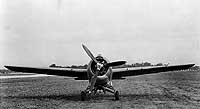 |
|
Photo #: 80-G-10613 Grumman F4F-3 "Wildcat" fighters, of Fighting Squadron Three (VF-3) In flight near Naval Air Station, Kaneohe, Oahu, Hawaii, 10 April 1942. The planes are Bureau # 3976 (marked "F-1), flown by VF-3 Commanding Officer Lieutenant Commander John S. Thach, and Bureau # 3986, flown by Lieutenant Edward H. O'Hare. Both of these aircraft were lost while assigned to Fighting Squadron Two (VF-2) with USS Lexington (CV-2), during the Battle of Coral Sea in May 1942. Photographed by Photographer Second Class H.S. Fawcett. Official U.S. Navy Photograph, now in the collections of the National Archives. Online Image: 111KB; 740 x 620 pixels Reproductions of this image may also be available through the National Archives photographic reproduction system. |
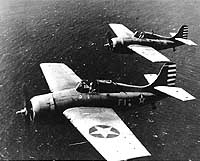 |
|
Photo #: NH 97493 Grumman F4F "Wildcat" fighter In flight, February 1942. Official U.S. Navy Photograph, from the collections of the Naval History and Heritage Command. Online Image: 68KB; 740 x 605 pixels |
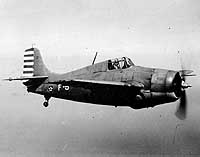 |
|
Photo #: 80-G-7026 Grumman F4F-4 "Wildcat" fighter, of Fighting Squadron 41 (VF-41) In flight, circa early 1942. Official U.S. Navy Photograph, now in the collections of the National Archives. Online Image: 43KB; 740 x 610 pixels Reproductions of this image may also be available through the National Archives photographic reproduction system. |
 |
|
Photo #: 80-G-16511 Grumman F4F-4 "Wildcat" fighter, of Fighting Squadron Six (VF-6) Has its six .50 caliber machine guns tested on the flight deck of USS Enterprise (CV-6), 10 April 1942. Note open gun bays in the plane's wings and markings below the cockpit ("6F9" with no dashes between letters and numerals). Official U.S. Navy Photograph, now in the collections of the National Archives. Online Image: 93KB; 740 x 605 pixels Reproductions of this image may also be available through the National Archives photographic reproduction system. |
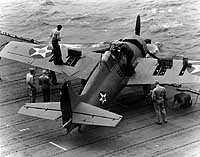 |
|
Photo #: 80-G-66154 Grumman F4F-4 "Wildcat" Fighter (Bureau # 5171), of Fighting Squadron Three (VF-3) At Naval Air Station, Kaneohe, Oahu, on 29 May 1942, with ground crewmen folding the starboard wing. On 4 June 1942, in the Battle of Midway, this plane was flown by Lieutenant Commander John S. Thach, VF-3's Commanding Officer, during the afternoon combat air patrol defending USS Yorktown (CV-5), wherein Thach probably shot down Lieutenant Joichi Tomonaga, leader of the attacking Japanese torpedo planes. Official U.S. Navy Photograph, now in the collections of the National Archives. Online Image: 62KB; 740 x 595 pixels Reproductions of this image may also be available through the National Archives photographic reproduction system. |
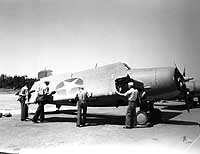 |
|
Photo #: 80-G-37932 Guadalcanal Campaign, 1942-1943 Marine Corps Grumman F4F "Wildcat" fighter at Henderson Field, 2 February 1943. Markings under the cockpit indicate that this plane has been credited with shooting down 19 Japanese aircraft, while being flown by several different pilots. Official U.S. Navy Photograph, now in the collections of the National Archives. Online Image: 98KB; 740 x 610 pixels Reproductions of this image may also be available through the National Archives photographic reproduction system. |
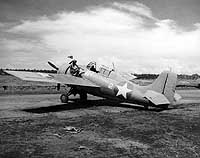 |
|
Photo #: 80-G-K-15634 (Color) Grumman F4F-4 "Wildcat" fighter (nicknamed "Rosenblatt's Reply") On board USS Suwanee (ACV-27), circa late 1942 or early 1943. The plane bears traces of the yellow Operation "Torch" marking around its national insignia. Photographed by Ensign Barrett Gallagher, USNR. Official U.S. Navy Photograph, now in the collections of the National Archives. Online Image: 50KB; 740 x 535 pixels Reproductions of this image may also be available through the National Archives photographic reproduction system. |
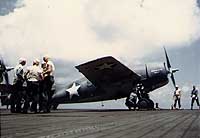 |
|
Photo #: 80-G-K-15611 (Color) Grumman F4F-4 "Wildcat" fighter Receives maintenance at a Stateside air base, circa 1942-43. Official U.S. Navy Photograph, now in the collections of the National Archives. Online Image: 61KB; 500 x 765 pixels Reproductions of this image may also be available through the National Archives photographic reproduction system. |
 |
|
Photo #: NH 97484 Grumman F4F "Wildcat" fighters Fly in tactical formation of four-plane divisions, comprised of two-plane sections, circa mid-1943. The planes are wearing the red-outlined national insignia briefly employed at that time. The original caption states, in describing that insignia: "Note the new U.S. insignia, marked by the addition of a white bar, bordered in red, on each side of the star-and-circle. Formerly, U.S. insignia, the Jap rising sun and the German Cross all appeared as similar small dots to American pilots, when view(ed) at a distance." The original print is from Rear Admiral Samuel Eliot Morison files. U.S. Naval History and Heritage Command Photograph. Online Image: 66KB; 610 x 675 pixels |
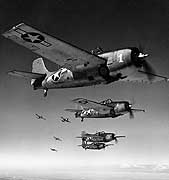 |
For further views of "Wildcat" fighters, see:
NOTES:
| If you want higher resolution reproductions than the digital images presented here, see: "How to Obtain Photographic Reproductions." |
Page made 21 January 2001
Coding updated 6 May 2009